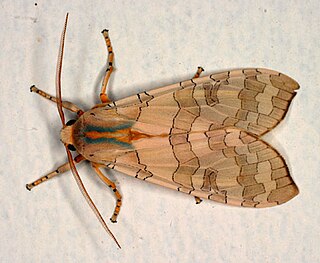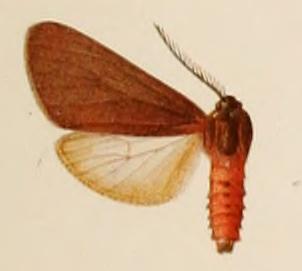
The Arctiinae are a large and diverse subfamily of moths with around 11,000 species found all over the world, including 6,000 neotropical species. This subfamily includes the groups commonly known as tiger moths, which usually have bright colours, footmen, which are usually much drabber, lichen moths, and wasp moths. Many species have "hairy" caterpillars that are popularly known as woolly bears or woolly worms. The scientific name Arctiinae refers to this hairiness. Some species within the Arctiinae have the word "tussock"' in their common names because they have been misidentified as members of the Lymantriinae subfamily based on the characteristics of the larvae.

Euchaetes egle, the milkweed tiger moth or milkweed tussock moth, is a moth in the family Erebidae and the tribe Arctiini, the tiger moths. The species was first described by Dru Drury in 1773. It is a common mid- through late summer feeder on milkweeds and dogbane. Like most species in this family, it has chemical defenses it acquires from its host plants, in this case, cardiac glycosides. These are retained in adults and deter bats, and presumably other predators, from feeding on them. Only very high cardiac glycoside concentrations deterred bats, however. Adults indicate their unpalatability to bats with ultrasonic clicks from their tymbal organs.

The Phaegopterina are a subtribe of tiger moths in the tribe Arctiini, which is part of the family Erebidae. The subtribe was described by William Forsell Kirby in 1892. 469 species of Phaegopterina are present and 52 that are recently discovered in Brazil.

Euchaetes fusca is a moth of the family Erebidae. It is found from the south-western United States to Costa Rica.
Euchaetes albaticosta is a moth of the family Erebidae. It was described by Harrison Gray Dyar Jr. in 1912. It is found in Mexico.
Euchaetes albicosta is a moth of the family Erebidae. It was described by Francis Walker in 1855. It is found from Texas, south to Mexico and Nicaragua.
Euchaetes antica is a moth of the family Erebidae. It was described by Francis Walker in 1856. It is found from Arizona and New Mexico in the US, south to Mexico, Nicaragua, Honduras and Guatemala.
Euchaetes bicolor is a moth of the family Erebidae. It was described by Walter Rothschild in 1935. It is found in São Paulo, Brazil.
Euchaetes bolteri is a moth of the family Erebidae. It was described by Richard Harper Stretch in 1885. It is found from the US states of Texas and New Mexico to Mexico and Costa Rica.
Euchaetes castalla is a moth of the family Erebidae. It was described by William Barnes and James Halliday McDunnough in 1910. It is found in the US state of Arizona.
Euchaetes cressida is a moth of the family Erebidae. It was described by Harrison Gray Dyar Jr. in 1913. It is found in the US state of Texas and Mexico.
Euchaetes expressa is a moth of the family Erebidae. It was described by Henry Edwards in 1884. It is found in Mexico and Costa Rica.
Euchaetes pannycha is a moth of the family Erebidae. It was described by Harrison Gray Dyar Jr. in 1918. It is found in Mexico.
Euchaetes perlevis is a moth of the family Erebidae. It was described by Augustus Radcliffe Grote in 1882. It is found in the US states of Arizona, New Mexico and Texas.
Euchaetes polingi is a moth of the family Erebidae. It was described by Samuel E. Cassino in 1928. It is found in the US states of Arizona, New Mexico, Oklahoma and Texas.
Euchaetes promathides is a moth of the family Erebidae. It was described by Herbert Druce in 1894. It is found in Mexico.

Euchaetes zella is a moth of the family Erebidae. It was described by Harrison Gray Dyar Jr. in 1903. It is found in the US states of Arizona, California, Nevada, New Mexico, Oklahoma and Texas.

A MONA number, or Hodges number after Ronald W. Hodges, is part of a numbering system for North American moths found north of Mexico in the Continental United States and Canada, as well as the island of Greenland. Introduced in 1983 by Hodges through the publication of Check List of the Lepidoptera of America North of Mexico, the system began an ongoing numeration process in order to compile a list of the over 12,000 moths of North America north of Mexico. The system numbers moths within the same family close together for identification purposes. For example, the species Epimartyria auricrinella begins the numbering system at 0001 while Epimartyria pardella is numbered 0002.




